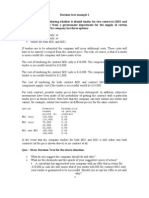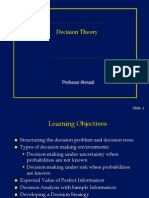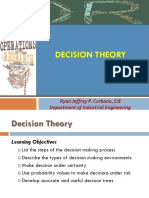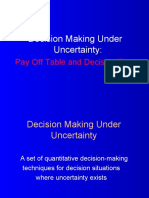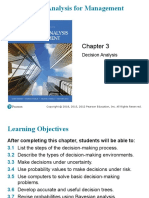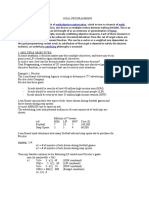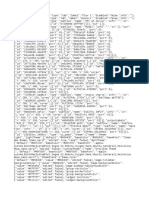DecisionTheory Ch8
DecisionTheory Ch8
Uploaded by
Alex BantonCopyright:
Available Formats
DecisionTheory Ch8
DecisionTheory Ch8
Uploaded by
Alex BantonOriginal Title
Copyright
Available Formats
Share this document
Did you find this document useful?
Is this content inappropriate?
Copyright:
Available Formats
DecisionTheory Ch8
DecisionTheory Ch8
Uploaded by
Alex BantonCopyright:
Available Formats
Managerial Decision Modeling
with Spreadsheets
Chapter 8
Decision Theory
Learning Objectives
List steps of decision making process.
Describe different types of decision making
environments.
Make decisions under uncertainty when
probabilities are not known.
Make decisions under risk when probabilities are
known.
Use Excel for problems involving decision tables.
Develop accurate and useful decision trees.
Revise probability estimates using Bayesian
analysis
8.1 Introduction
Decision theory is analytic and systematic approach to
study of decision-making.
What makes difference between good and bad
decisions?
Good decisions may be defined as:
Based on logic,
Considered all possible decision alternatives,
Examined all available information about future, and
Applied decision modeling approach.
Bad decision may be defined as:
Not based on logic,
Did not use all available information,
Did not consider all alternatives, and
Did not employ appropriate decision modeling techniques.
8.2 Five Steps of Decision Making
1. Clearly define problem at hand.
2. List all possible decision alternatives.
3. Identify possible future outcomes for each decision
alternative.
4. Identify payoff (usually, profit or cost) for each
combination of alternatives and outcomes.
5. Select one of decision theory modeling techniques,
apply decision model, and make decision.
Thompson Lumber Co. Example
Decision: Whether or not to make and sell
storage sheds
Alternatives:
Build a large plant
Build a small plant
Do nothing
Outcomes: Demand for sheds will be high,
moderate, or low
Thompson Lumber Co
Alternatives
Outcomes (Demand)
High Moderate Low
Large plant 200,000 100,000 -120,000
Small plant 90,000 50,000 -20,000
No plant 0 0 0
Payoff Table
Components of Decision Making
Payoff Table
A state of nature is an actual event that may occur in the
future.
A payoff table is a means of organising a decision
situation, presenting the payoffs from different decisions
given the various states of nature.
8.3 Types Of Decision Making
Environments
Type 1: Decision Making under Certainty. Decision maker
knows with certainty consequence of every decision alternative.
Type 2: Decision Making under Uncertainty. Decision maker
has no information about various outcomes.
Type 3: Decision Making under Risk. Decision maker has
some knowledge regarding probability of occurrence of each
outcome or state of nature.
Examples:
Probability of being dealt club from deck of cards is 1/4.
Probability of rolling 5 on die is 1/6.
8.4 Decision Making Under Uncertainty
Criteria for making decisions under uncertainty.
1. Maximax.
2. Maximin.
3. Equally likely (LaPlace).
4. Criterion of realism (Hurwicz).
5. Minimax (or minmax) regret.
First four criteria calculated directly from decision
payoff table.
Fifth minmax regret criterion requires use of
opportunity loss (regret) table.
Maximax Criterion (Profits)
Maximax criterion selects alternative maximises
maximum (best) payoff over all alternatives.
First locate maximum (best) payoff for each alternative.
Select alternative with maximum (best) number.
Criterion locates alternative with highest possible gain.
Called optimistic criterion.
Alternatives Maximum
Large plant 200,000
Small plant 90,000
No plant 0
Decision: Since Large
Plant carries the
maximum of 200,000,
the decision is to build
Large Plant
Thompson Lumber
Maximin Criterion (Profits)
Maximin criterion finds alternative which maximises
minimum payoff over all alternatives.
First locate minimum (worst) payoff for each alternative.
Select alternative with maximum (best) number.
Criterion locates alternative that has least possible loss.
Called pessimistic criterion.
Alternatives Minimum
Large plant -120,000
Small plant -20,000
No plant 0
Decision: Since No Plant
carries the maximum of min
(best of the worst) 0, the
decision is No Plant
Thompson Lumber
Equally Likely (LaPlace) Criterion
Equally likely, also called LaPlace, criterion finds
decision alternative with highest average payoff (profits);
lowest average payoff (costs).
Calculate average payoff for every alternative.
Pick alternative with maximum average payoff.
Assumes all probabilities of occurrence for states of
nature are equal.
Choices Average
Large plant (200,000+100,000-120,000)/3 = 60,000
Small plant (90,000 + 50,000 - 20,000)/3 = 40,000
No plant (0 + 0 + 0)/3 = 0
Decision: Large plant
Thompson Lumber
Criterion of Realism (Hurwicz)
Often called weighted average, the criterion of
realism (or Hurwicz) decision criterion is a
compromise between optimistic and pessimistic
decision.
Select coefficient of realism, o, with value between 0
and 1.
When o is close to 1, decision maker is optimistic
about future.
When o is close to 0, decision maker is pessimistic
about future.
Hurwicz Criterion
Apply o to the BEST payoff and (1- o ) to the WORST
For Hurwicz in PROFITS = o*(max) + (1-o)*(min)
Assume coefficient of realism o = 0.45. So 1- o = 0.55
Choices Average
Large plant 0.45*200,000 + 0.55*(-120,000) = 24,000
Small plant 0.45* 90,000 + 0.55 * (-20,000) = 29,500
No plant 0.45*0+0.55*0 = 0
Decision: Small plant
Thompson Lumber
Not that when applied to the Costs, goes with the
LOWEST
Minimax Regret Criterion
Final decision criterion is based on opportunity loss.
Opportunity loss, also called regret, is difference between
optimal payoff and actual payoff received.
Develop opportunity loss (regret) table.
Determine opportunity loss of not choosing best alternative for
each state of nature.
Opportunity loss for any state of nature, or any column, is
calculated by subtracting each outcome in column from best
outcome in same column. PROFITS
Opportunity loss for any state of nature, or any column, is
calculated by subtracting best outcome in same column
from each outcome in column: COSTS
Payoffs are Profits
States of Nature (Market)
Decision High Moderate Low
Large Plant 200,000 200,000 100,000 100,000 0 120,000
Small Plant 200,000 90,000 100,000 50,000 0 20,000
No Plant 200,000 0 100,000 0 0 0
Calculating Regrets
Note that for each STATE OF NATURE, we find the best
(highest) payoff and FROM it we subtract all the rest. If
the payoffs were cost, then the best is the LOWEST and it
is SUBTRACTED FROM all the rest in that state of
nature. We cannot have negative regrets.
Minimax Regret Criterion
Thompson Lumber
Regrets
States of Nature (Market)
Alternatives High Moderate Low
Large Plant 0 0 120,000
Small Plant 110,000 50,000 20,000
No Plant 200,000 100,000 0
Maximum
120,000
110,000
200,000
Decision. Choose Small Plant for it has the minimum
of the max regrets.
Note that we do not ADD regrets, but find the maximum.
8.5 Decision Making Under Risk
Common for decision maker to have some idea about
probabilities of occurrence of different outcomes or
states of nature.
Probabilities may be based on decision makers
personal opinions about future events, or on data
obtained from market surveys, expert opinions, etc.
When probability of occurrence of each state of nature
can be assessed, problem environment is called
decision making under risk.
Expected Monetary Value
Given decision table with conditional values (payoffs) and
probability assessments, determine expected monetary value
(EMV) for each alternative.
Computed as weighted average of all possible payoffs for
alternative, where weights are probabilities of different states
of nature:
EMV (alternative i) =
(payoff of first state of nature) x (probability of first
state of nature) +
(payoff of second state of nature) x (probability of second
state of nature) + . . . +
(payoff of last state of nature) x (probability of last
state of nature)
Expected Monetary Value
If the probability of high is 30%, of medium 50%, and of low
is 20%. Using EMV, what option should be chosen and what is
that optimal expected value? This value is called expected
value without perfect information = EWoPI
Thompson Lumber
0.20 0.50 0.30 Probability
0 0 0 0 No Plant
48,000 -20,000 50,000 90,000 Small Plant
86,000 -120,000 100,000 200,000 Large Plant
EMV Low Mod High Alternatives
E.g. (0.3*200,000)+(0.5*100,000)+(0.3*-120,000) = 86,000
Decision Large Plant. EMV = 86,000.
Expected Value of Perfect Information
Expected value with perfect information is expected or average
return, if one has perfect information before decision has to be
made.
Choose best alternative for each state of nature and multiply its
payoff times probability of occurrence of that state of nature:
Expected value with perfect information (EV with PI) =
(best payoff for first state of nature)
x (probability of first state of nature)
+ (best payoff for second state of nature)
x (probability of second state of nature)
+ . . . + (best payoff for last state of nature)
x (probability of last state of nature)
(1) EVPI = EV with PI - EWoPI
(2) EVPI = MINIMUM Expected Regret.
EV with PI and EVPI
Best outcome for state of nature high is Large Plant with a
payoff of 200,000; Best outcome for state of nature Moderate
is Large Plant with payoff of 100,000 and best outcome for
state of nature low is no plant with a payoff of 0.
Expected value with perfect information
(EV with PI) = (200,000)(0.3) + (100,000)(0.5) + (0)(0.2)
= 110,000. This is called EWPI
If one had perfect information, an average payoff of 110,000 if
decision could be repeated many times.
Maximum EMV or expected value without perfect information,
is 86,000. This is called EWoPI
EVPI = EWPI EWoPI = 110,000 86,000 = 24,000.
EVPI From Regrets
Calculate Expected Value for all Decision Alternatives.
Identify Minimum Expected Regret (Opportunity Loss)
This is EVPI = 24,000
Thompson Lumber
Alternatives
Outcomes (Demand)
High
Moderate
Low
Large plant 0 0 120,000
Small plant 110,000 50,000 20,000
No plant 200,000 100,000 0
EOL
24,000
62,000
110,000
Probability 0.3 0.5 0.2
Decision Trees
Any problem presented in decision table can be
graphically illustrated in decision tree.
All decision trees are similar in that they contain
decision nodes (or points) and state of nature nodes
(or points).
These nodes are represented using following symbols:
= A decision node.
Arcs (lines) originating from decision node denote all
decision alternatives available at that node.
= A state of nature (or chance) node.
Arcs (lines) originating from a chance node denote all
states of nature that could occur at that node.
8.6 Solving Decision Trees
Draw (grow) decision trees from LEFT to RIGHT .
Solve Decision trees from RIGHT to LEFT.
Operate at NODES only (Please number all nodes)
Calculate (only) expected values at state of nature nodes
Make decisions at decision nodes
Fold back optimal expected values. That is, at every decision
node, write optimal value obtained from that decision.
Prune (using double slash), the INFERIOR decisions
State optimal decision from LEFT to RIGHT.
Follow UNPRUNED decisions
At state of nature points say IF
Report the Optimal Expected value of Node 1.
Smith Manufacturing
The Smith Manufacturing Company must decide whether it
should purchase a component part from a supplier or make the
part itself at its St. Lucia plant. Figures are $0,000.
If demand turns out to be high (H), the net profits from purchase
is $70 and from manufacture is $100. If demand turns out to be
medium (M), the net profits from purchase is $45 and from
manufacture is $40. If demand turns out to be low (L), the net
profits from purchase is $10 and from manufacture is - $20
(loss). The probabilities are high: 0.3; medium: 0.35; low: 0.35
Smith may have a test market study done by a market research
company. The response will be either favourable (probability
0.35) or unfavourable. This test costs $2.5. If the test is done,
then the probabilities would be revised. P(H|F) = 0.5; P(M|F) =
0.4; P(L|F) = 0.1; P(H|U) = 0.2; P(M|U) = 0.32; P(L|U) = 0.48
Smith Manufacturing
Requirements (for all decision trees).
Draw a decision tree in logical order.
Decision alternatives
States of nature
Payoffs (net)
Probability values
Solve the decision tree by folding back method
State optimal decision and optimal EMV
What is the Expected Value of Sample Information
(EVSI) which is the most that should be paid for the test?
What is the EVPI?
What is the Efficiency of Sample Information?
Smith Manufacturing Solution
In all decision trees there is a logical order of events. A
tree cannot be put together arbitrarily. Even if all the
components are right but they are in the wrong places,
the tree is wrong!! Bear these points in mind.
Certain outcomes follow certain decisions only. You must
identify all the decisions and their respective outcomes. The
outcomes must immediately follow their decisions.
In the event that there is sample or survey information that may
be collected (it is an option), this cannot be done after the main
decision(s); it must be done before.
The decision maker who chooses to collect sample information,
must await the outcome of the sample information before
proceeding o his or her main decision
Irrespective of the outcome of sample information, the main
decision(s) are always available to the decision maker
Decision Tree
Tree usually begins with decision node.
Since there is the option of a test market study, then
Smith should choose whether to do it or not, before
deciding between the make or buy (main) decisions.
Smith Manufacturing
Two decision alternatives
Decision point
Decision Tree
Following the option to test the market we immediately
put its outcomes and NEVER nowhere else. Also write
the probabilities if known.
State of nature point
Two states of nature (their
probabilities must sum to 1)
Decision Tree
Following the test market results, or the decision not to test,
Smith must now decide between make or buy (or do nothing).
The do nothing option must always be considered if it is better
than an existing option (to prevent a loss when it can be avoided)
Following
the make or
buy decision
in ALL
CASES the
outcomes
that follow
are demand
high,
medium or
low.
1
2
5
4
3
6
7
10
9
8
11
P(M) = 0.35
P(M) = 0.35
P(M|F) = 0.4
P(M|F) = 0.4
P(M|U) = 0.32
97.5
37.5
-22.5
67.5
42.5
7.5
100
40
-20
70
45
10
7.5
42.5
67.5
-22.5
37.5
97.5
Complete the tree
by including the
NET payoffs.
Since the test costs
2.5, all payoffs
that follow must
go down by 2.5
Folding Back a Decision Tree
In folding back decision tree, use following two rules:
At each state of nature node, compute expected value using
probabilities of all possible outcomes at that node and payoffs
associated with outcomes.
At each decision node, select alternative that yields better
expected value or payoff.
EV (6) = (0.3*100)+ (0.35*40)+(0.35*-20) = 37
EV (7) = (0.3*70)+ (0.35*45)+(0.35*10) = 40.25
EV (8) = (0.5*97.5)+ (0.4*37.5)+(0.1*-22.5) = 61.5
EV (9) = (0.5*67.5)+ (0.4*42.5)+(0.1*7.5) = 51.5
EV (10) = (0.20*97.5)+ (0.32*37.5)+(0.48*-22.5) = 20.7
EV (11) = (0.20*67.5)+ (0.32*42.5)+(0.48*7.5) = 30.7
Write the values at the nodes!!
1
2
5
4
3
6
7
10
9
8
11
P(M) = 0.35
P(M) = 0.35
P(M|F) = 0.4
P(M|F) = 0.4
P(M|U) = 0.32
97.5
37.5
-22.5
67.5
42.5
7.5
100
40
-20
70
45
10
7.5
42.5
67.5
-22.5
37.5
97.5
40.25
61.5
51.5
20.7
30.7
37
Expected values
written at nodes, now
make decision at 3, 4
and 5
Choose between
make or buy at each
point, based on best
value
1
2
5
4
3
6
7
10
9
8
11
P(M) = 0.35
P(M) = 0.35
P(M|F) = 0.4
P(M|F) = 0.4
P(M|U) = 0.32
97.5
37.5
-22.5
67.5
42.5
7.5
100
40
-20
70
45
10
7.5
42.5
67.5
-22.5
37.5
97.5
40.25
61.5
51.5
20.7
30.7
37
At 4, choose make
At 5, choose buy
At 3, choose buy
1
2
5
4
3
6
7
10
9
8
11
P(M) = 0.35
P(M) = 0.35
P(M|F) = 0.4
P(M|F) = 0.4
P(M|U) = 0.32
97.5
37.5
-22.5
67.5
42.5
7.5
100
40
-20
70
45
10
7.5
42.5
67.5
-22.5
37.5
97.5
40.25
61.5
51.5
20.7
30.7
37
40.25
61.5
30.7
Folding back the
optimal values,
pruning the inferior
decisions
Pruning
Now Calculate
EV at node 2
EV(2) = 0.35*61.5+0.65*30.7 = 41.48
1
2
5
4
3
6
7
10
9
8
11
P(M) = 0.35
P(M) = 0.35
P(M|F) = 0.4
P(M|F) = 0.4
P(M|U) = 0.32
97.5
37.5
-22.5
67.5
42.5
7.5
100
40
-20
70
45
10
7.5
42.5
67.5
-22.5
37.5
97.5
40.25
61.5
51.5
20.7
30.7
37
40.25
61.5
30.7
41.48
41.48
Write EV at 2, and make
decision at node 1
Bring back optimal EV to
node 1.
Stating Decision, EVSI, EVPI, Efficiency
Decision: Do the market test, if favourable MAKE
(manufacture) the part but if unfavourable, Buy the part
Optimal EV is 41.48
EVSI: One way of measuring value of market
information is to compute the expected value of sample
information (EVSI), as follows:
EVSI = EWSI EWoSI (Profits)
EVSI = EWoSI EWSI (Costs)
Expected Value of Sample Information
|
|
|
|
|
|
|
|
.
|
\
|
|
|
|
|
|
|
|
|
.
|
\
|
=
n informatio
sample
decision best of
value Expected
it gather cost to
no assuming
n, informatio
sample
decision best of
value Expected
without with
EVSI
Add BACK the costs subtracted first
EVSI = EWSI EWoSI = 41.48 + 2.5 40.25 = 3.73
EVSI with Cost Minimisation
When dealing with costs: EVSI = EWoSI EWSI
=
it gather cost to
no assuming
n informatio
sample
decision best of
value Expected
n, informatio
sample
decision best of
value Expected
with without
EVSI
Subtract the costs added earlier
EVPI
EVPI is obtained from NO TEST SIDE ONLY!!
EVPI = EWPI EWoPI (Profits)
This is expected value of perfect information,
uncontaminated by sample information.
EWoPI = optimal EV at No Test Decision = 40.25
EWPI = 0.3*100 + 0.35*45 + 0.35*10 = 49.25
EVPI = 49.25 40.25 = 9.00
100 is best expected value if we knew demand was going
to be high; 45 is best if we knew it was medium and 10 is
best if we knew demand was going to be low.
Efficiency of Sample Information
How close does the sample information come to
perfect information?
Efficiency of sample information
= EVSI | EVPI
Efficiency = EVSI/EVPI % = 3.73/9 = 41.44%
Expanded Thompson
Lumber Example
Suppose they will first decide whether to pay
$4000 to conduct a market survey
Survey results will be imperfect
Then they will decide whether to build a large
plant, small plant, or no plant
Then they will find out what the outcome and
payoff are
Marketing Reliability of Research Firm
The marketing research firm provided the following
probabilities based on its track record of survey
accuracy:
P(V|H) = 0.967 P(N|H) = 0.033
P(V|M) = 0.533 P(N|M) = 0.467
P(V|L) = 0.067 P(N|L) = 0.933
That is, for example, in the past, when demand
was high, it reported positive 96.7% of the time
and negative 3.3% of the time
Here V = the event the survey result is positive and
N = the event the result is negative N = V
Questions
What should Thompson Lumber do now?
Use a decision tree this time.
You have to revise probabilities using law of Total
Probability and Bayes Theorem.
What is the optimal decision and optimal EMV?
What is EVSI?
What is EVPI?
What is the efficiency of sample information?
Shamrock Oil (Same Questions)
Shamrock Oil owns a parcel of land that has the
potential to be an underground oil field. It will
cost $500,000 to drill for the oil. If oil does exist
on the land, Shamrock will realize a payoff of
$4,000,000 (not including drilling costs). With
current information, Shamrock estimates that there
is a 20% probability that oil is present on the site.
Shamrock also has the option of selling the land as
is for $400,000 without further information about
the likelihood of oil being present.
Shamrock Oil continued
A firm can perform geological tests at the site,
which would cost $100,000. Shamrock Oil has
some information concerning the accuracy of the
geological test probabilities. According to this
information, the probability that the test will be
positive given that oil is present in the ground is
85%. The probability that the test will be negative
given that oil is not present is 75%. If the test
results are positive Shamrock can sell the land for
$650,000 or continue to drill. If the test results are
negative, Shamrock can sell the land for $50,000 or
drill the land for oil.
Decision Theory 2. Bobs Bike Shop
Bobs Bike Shop is considering three options for his
facility next year. He can expand his current shop, move
to a larger facility, or make no change. With a
favourable market, the annual payoff would be $56000 if
he expands, $70000 if he moves, and $30000 if he does
nothing. With an average market, his payoff will be
$21000, $35000, and $10000 respectively. With an
unfavourable market, his payoff will be $-29000, $-
45000, and $5000 respectively.
Bobs Payoff Table
Payoffs are Profits
States of Nature (Market)
Decision
Alternatives Favourable Average Unfavourable
Expand $56,000 $21,000 $29,000
Move $70,000 $35,000 $45,000
No Change $30,000 $10,000 $5,000
Bobs Bike Shop
Decision Theory 3. Tees R Us
Tees R Us manufactures and sells tee shirts for
sporting events. They are providing tee shirts for an
upcoming event with the following financial data.
Each tee shirt that is MADE will cost $10
Each tee shirt that is SOLD will generate $16 revenue
Each tee shirt that was made but NOT SOLD will be
salvaged for $5 (this is revenue)
There is no cost for lost sales (demand greater than
amount made)
Tees R Us
Tees R Us believes that demand will be 1,000,
2,000, 3,000 or 4,000 tee shirts. They need to
decide whether to produce 1,000, 2,000, 3,000 or
4,000 tee shirts.
Create a payoff table that shows the quantity made
(in row) and possible demand - states of nature (in
column) where payoffs = profits.
Answer the questions that follow
Questions
Complete the payoff table for Tees R Us (TRU)
Using maximax, what quantity should Tees R Us make?
Using maximin, what quantity should Tees R Us make?
For a LaPlace decision maker, what quantity should TRU make?
Using Hurwicz, what quantity should TRU make = 0.7?
Using a minmax regret approach, which option would you
choose?
If the demand probabilities are 0.15, 0.25, 0.30 and 0.30,
respectively which quantity will maximise expected profit?
What is the expected profit associated with that
recommendation?
What is the most the firm should be willing to pay to obtain
further (perfect) information (EVPI) concerning the actual
demand?
Decision Theory 4. Data Processing (Costs)
A firm is considering three options for managing its data
processing operation: continuing with its own staff, hiring an
outside vendor to do the managing (referred to as outsourcing), or
a combination of its own staff and outside vendor. The cost of
the operation depends on future demand. The annual cost of each
decision alternative and state of nature (in thousands of dollars) is
as follows: (Objective is to MINIMISE costs)
States of Nature (Demand)
Alternative High Medium Low
Own staff 650 650 600
Vendor 900 600 300
Combination 800 650 500
Questions Data Processing
Using maximax, what option should the firm choose?
Using maximin, what option should the firm choose?
For a LaPlace, what option should the firm choose?
Using Hurwicz, what option should be chosen? Make =
0.7?
Using a minmax regret approach, which option would you
choose?
If the demand probabilities are 0.3, 0.3, and 0.4, respectively
which option will minimise expected cost? What is the
expected cost associated with that recommendation?
What is the most the firm should be willing to pay to obtain
further (perfect) information (EVPI) concerning the actual
demand?
Maximax Criterion (Costs)
Maximax criterion selects alternative which minimises
minimum (best) payoff over all alternatives.
First locate minimum payoff for each alternative.
Select alternative with minimum number.
Decision criterion locates alternative with lowest
possible cost.
Alternatives Minimum
Own Staff 600
Vendor 300
Combination 500
Decision: Since
Vendor carries the
minimum of 300,
the decision is to
use Vendor
Data Processing question
Maximin Criterion (Costs)
Maximin criterion finds alternative which minimises
worst (maximum in costs) payoff over all alternatives.
First locate worst (highest) cost for each alternative.
Select alternative with minimum (best) number.
Criterion locates alternative that has lowest of max cost.
Called pessimistic criterion.
Alternatives Max (worst)
Own Staff 650
Vendor 900
Combination 800
Decision: Since Own
Staff carries the minimum
of the maximum costs =
600, the decision is to use
Own Staff
Data Processing Operation
You might also like
- Questions For Decision Tree AnalysisDocument2 pagesQuestions For Decision Tree AnalysisTHE TERMINATORNo ratings yet
- Chap18 DecisionDocument36 pagesChap18 Decisionawaisjinnah75% (4)
- Linear Programming On Computer - Ch78Document96 pagesLinear Programming On Computer - Ch78Maria SalmanNo ratings yet
- Error Codes Table Hyundai R290LC-7Document14 pagesError Codes Table Hyundai R290LC-7milad rahimi100% (2)
- Decision TreesDocument23 pagesDecision TreesPhaedon LomisNo ratings yet
- Decision AnalysisDocument37 pagesDecision AnalysisMay Ann Agcang SabelloNo ratings yet
- Decision TheoryDocument35 pagesDecision TheoryPushpa Latha M100% (1)
- Decision Tree Examples For 5th SessionDocument8 pagesDecision Tree Examples For 5th Sessionpraveen25in100% (2)
- Decision Tree Analysis Example-Question & AnswersDocument19 pagesDecision Tree Analysis Example-Question & AnswersDuduzile Ndlovu100% (3)
- Goal ProgrammingDocument16 pagesGoal ProgrammingRajesh MishraNo ratings yet
- Topic 4 Transportation and Assignment Models - Chapter 9Document64 pagesTopic 4 Transportation and Assignment Models - Chapter 9Hong Zaii50% (2)
- 2.1 Decision TheoryDocument7 pages2.1 Decision TheoryJairiel JenuinNo ratings yet
- Chapter 3 Homework - Quantitive Analysis For ManagementDocument3 pagesChapter 3 Homework - Quantitive Analysis For ManagementDaisyNo ratings yet
- Decision Making Under RiskDocument15 pagesDecision Making Under RiskJamie Arquiro100% (2)
- Exercise 1 - Decision Theory PDFDocument5 pagesExercise 1 - Decision Theory PDFKuthe Prashant Gajanan100% (1)
- Decision Tree ExampleDocument4 pagesDecision Tree ExampleRohit Upadhyay50% (2)
- Decision AnalysisDocument45 pagesDecision AnalysisHussien AliyiNo ratings yet
- Linear ProgrammingDocument15 pagesLinear ProgrammingMoid Aretaño MesaNo ratings yet
- Decisionth 1Document66 pagesDecisionth 1Vijayant Panda100% (1)
- Decision TreeDocument26 pagesDecision TreePriya GaNo ratings yet
- Lec - 7 Decision AnalysisDocument63 pagesLec - 7 Decision AnalysisMujahidKhan100% (1)
- Topic 1 Decision Analysis Chapter 3Document54 pagesTopic 1 Decision Analysis Chapter 3Kent Nice100% (5)
- Decision AnalysisDocument60 pagesDecision AnalysisDaniel Lalas Padayhag100% (1)
- Decision AnalysisDocument49 pagesDecision AnalysisSeong Hyeon LeeNo ratings yet
- Decision TheoryDocument32 pagesDecision TheoryAmul Shrestha100% (1)
- Quantitative Methods For Decision Making: Dr. Tanvir AbirDocument35 pagesQuantitative Methods For Decision Making: Dr. Tanvir AbirFaria Anjum FihaNo ratings yet
- Decision Theory Model - Lec03.1Document29 pagesDecision Theory Model - Lec03.1Libres Twin100% (1)
- Intro To Decision AnalysisDocument38 pagesIntro To Decision AnalysisAna Paula Albert100% (1)
- Decision Analysis: Quantitative TechniquesDocument7 pagesDecision Analysis: Quantitative TechniquesDennisBrionesNo ratings yet
- Lecture 3 - Decision AnalysisDocument54 pagesLecture 3 - Decision Analysisqwerzhai100% (1)
- Decision Theory PPT (Mba3) 2011Document140 pagesDecision Theory PPT (Mba3) 2011Sarita Thakur100% (1)
- Decision Making Under Uncertainty Decision TreeDocument32 pagesDecision Making Under Uncertainty Decision TreeEko Nopianto100% (1)
- Quantitative TechniquesDocument29 pagesQuantitative Techniquesbaby ann100% (3)
- Multi Goal Programming and Its Application in ExcelDocument20 pagesMulti Goal Programming and Its Application in ExcelAbhishekSharma100% (1)
- Chapter Five Decision Theories and AnalysisDocument47 pagesChapter Five Decision Theories and AnalysisAbdela AyalewNo ratings yet
- Cost EstimationDocument37 pagesCost EstimationDani Wedaje100% (1)
- Goal ProgrammingDocument12 pagesGoal ProgrammingAashrith ParvathaneniNo ratings yet
- Decision AnalysisDocument46 pagesDecision AnalysisthaamelodyNo ratings yet
- CH 1 Decision AnalysisDocument49 pagesCH 1 Decision Analysiseleni100% (1)
- Manegerial Economics (Risk Analysis Presentation)Document39 pagesManegerial Economics (Risk Analysis Presentation)Faheem Ul HassanNo ratings yet
- Probabilistic Dynamic Programming (Stochastic Dynamic Programming)Document12 pagesProbabilistic Dynamic Programming (Stochastic Dynamic Programming)Ysma Yee100% (1)
- Linear Programming Models: Graphical and Computer Methods: To AccompanyDocument18 pagesLinear Programming Models: Graphical and Computer Methods: To AccompanyAbigail Faye RoxasNo ratings yet
- Chapter 3 - Decision AnalysisDocument50 pagesChapter 3 - Decision AnalysisAbo Fawaz0% (1)
- Decision TreeDocument5 pagesDecision TreesneharachNo ratings yet
- Linear Programming Simplex MethodDocument9 pagesLinear Programming Simplex MethodJam MiralloNo ratings yet
- Utility and Game TheoryDocument37 pagesUtility and Game Theorygzel07100% (1)
- Goal Programming Is A Branch Of: Multiobjective Optimization Multi-Criteria Decision Analysis Linear ProgrammingDocument8 pagesGoal Programming Is A Branch Of: Multiobjective Optimization Multi-Criteria Decision Analysis Linear Programminghemnt92No ratings yet
- Transportation Problem in Operation ResearchDocument60 pagesTransportation Problem in Operation ResearchRatnesh SinghNo ratings yet
- Sensitivity AnalysisDocument6 pagesSensitivity AnalysisSupriya Gunthey RanadeNo ratings yet
- Decision TreesDocument53 pagesDecision TreesKarl100% (1)
- Facility LocationDocument50 pagesFacility Locationsachin121083No ratings yet
- Chapter 3Document54 pagesChapter 3Jessica M. SantanaNo ratings yet
- Hurwicz Criterion in Decision TheroryDocument11 pagesHurwicz Criterion in Decision TherorysubinNo ratings yet
- Big M MethodDocument12 pagesBig M MethodEshan MaheshwariNo ratings yet
- Economic AnalysisDocument24 pagesEconomic AnalysisVanessa Bernardino100% (1)
- Decision TreeDocument13 pagesDecision TreeratnamsNo ratings yet
- Solution For Exercise 3Document16 pagesSolution For Exercise 3Amedeus Kizito Shayo100% (2)
- Chapter Four: Decision TheoryDocument45 pagesChapter Four: Decision TheoryAshenafi hunegnawNo ratings yet
- Decision Making TheoryDocument48 pagesDecision Making Theorydr.panu100% (2)
- CH 2 QuantatativeDocument14 pagesCH 2 QuantatativeAhmed MohamedNo ratings yet
- Decision TheoryDocument14 pagesDecision TheoryrishavNo ratings yet
- Resume - College Graduate Resume - 02Document2 pagesResume - College Graduate Resume - 02shivam singhNo ratings yet
- SQL Injection Cheat SheetDocument18 pagesSQL Injection Cheat SheetYahya Nursalim100% (1)
- Faculty of Management SciencesDocument24 pagesFaculty of Management SciencesMuhammad SafdarNo ratings yet
- Face Recognition Seminar Presentation Day1Document23 pagesFace Recognition Seminar Presentation Day1abdi geremewNo ratings yet
- 1 Blockly: Programming The Niryo One WithDocument20 pages1 Blockly: Programming The Niryo One Withjairo eduardoNo ratings yet
- 36 RH-3032 (Manual)Document71 pages36 RH-3032 (Manual)Nguyen Phuoc HoNo ratings yet
- LSMW Inp ZPM PM MeqDocument33 pagesLSMW Inp ZPM PM MeqErBikasKumarPathakNo ratings yet
- Webpage 170917061634Document19 pagesWebpage 170917061634Mark Joeseph LontokNo ratings yet
- Smartwaste Commercial: User Guide V2.0Document43 pagesSmartwaste Commercial: User Guide V2.0ReginaNo ratings yet
- RoboServer Users Guide PDFDocument25 pagesRoboServer Users Guide PDFdavid0young_2No ratings yet
- Wireless and Mobile Communications: Dr. T. ShankarDocument43 pagesWireless and Mobile Communications: Dr. T. Shankarmonu bNo ratings yet
- Zynq-7000 Ap Soc and 7 Series Devices Memory Interface Solutions (V4.0)Document13 pagesZynq-7000 Ap Soc and 7 Series Devices Memory Interface Solutions (V4.0)Evrim AltanNo ratings yet
- Microsoft Power Automate Dataverse Connector Cheatsheet v2024Document3 pagesMicrosoft Power Automate Dataverse Connector Cheatsheet v2024Vivek KumarNo ratings yet
- Microstation V8i Print OrganizerDocument15 pagesMicrostation V8i Print OrganizerGerry MalapitanNo ratings yet
- Ganesh Ramachandran: Phone: +91 - 7892401503 / +91 - 9620261078 MailtoDocument2 pagesGanesh Ramachandran: Phone: +91 - 7892401503 / +91 - 9620261078 MailtoRAJESHNo ratings yet
- Computing-II - Lecture Notes-IDocument72 pagesComputing-II - Lecture Notes-IhirkoNo ratings yet
- Cambridge International AS & A Level: Computer Science 9618/12Document16 pagesCambridge International AS & A Level: Computer Science 9618/12ramikawathsiluNo ratings yet
- Upgrade SAP Access Control 10.0-10.1 To 12.0Document28 pagesUpgrade SAP Access Control 10.0-10.1 To 12.0Shiva KalyanaramanNo ratings yet
- Oracle EPM 11-1-2 3 Tuning Guide v2Document110 pagesOracle EPM 11-1-2 3 Tuning Guide v2chanLng100% (2)
- ARM Architecture - Wikipedia, The Free Encyclopedia PDFDocument24 pagesARM Architecture - Wikipedia, The Free Encyclopedia PDFराहुल रुन्थालाNo ratings yet
- Sick NoderedDocument8 pagesSick NoderedMateo PožgajNo ratings yet
- Motherboard Voltage Regulator CircuitDocument22 pagesMotherboard Voltage Regulator Circuitleon_sfNo ratings yet
- Comparison - ModifiersDocument3 pagesComparison - Modifierscannabis1No ratings yet
- Biznet Internet Exchange Community v3Document6 pagesBiznet Internet Exchange Community v3Langganan Chanel 80No ratings yet
- Knoll Light Factory ManualDocument59 pagesKnoll Light Factory ManualNatalie WilliamsNo ratings yet
- DTT Principles: N. Jethi, Dir (E) DDK, BhubaneswarDocument34 pagesDTT Principles: N. Jethi, Dir (E) DDK, BhubaneswarShishir GuptaNo ratings yet
- Krogstie - 2012 - Model-Based Development and Evolution of Information Systems A Quality ApproachDocument18 pagesKrogstie - 2012 - Model-Based Development and Evolution of Information Systems A Quality ApproachDironNo ratings yet
- HiaDocument4 pagesHiappanagos5664No ratings yet







